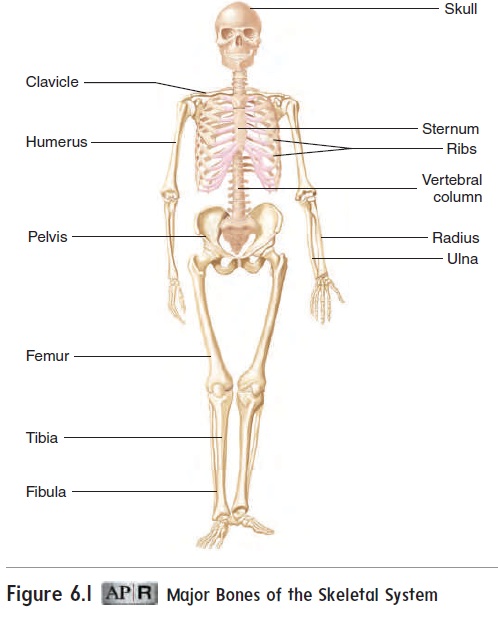Chapter: Essentials of Anatomy and Physiology: Skeletal System: Bones and Joints
Functions of the Skeletal System
FUNCTIONS OF THE SKELETAL SYSTEM
Sitting, standing, walking, picking up a pencil, and taking a breath all involve the skeletal system. Without the skeletal system, there would be no rigid framework to support the soft tissues of the body and no system of joints and levers to allow the body to move. The skeletal system consists of bones, such as those shown in figure 6.1, as well as their associated connective tissues, which include cartilage, tendons, and ligaments. The term skeleton is derived from a Greek word meaning dried. But the skeleton is far from being dry and nonliving. Rather, the skeletal system consists of dynamic, living tissues that are able to grow, detect pain stimuli, adapt to stress, and undergo repair after injury.

A joint, or an articulation, is a place where two bones come together. Many joints are movable, although some of them allow only limited movement; others allow no apparent movement. The structure of a given joint is directly correlated to its degree of movement.
Although the skeleton is usually thought of as the framework of the body, the skeletal system has many other functions in addi-tion to support.
The major functions of the skeletal system include
Support. Rigid, strong bone is well suited for bearingweight and is the major supporting tissue of the body. Cartilage provides firm yet flexible support within certain structures, such as the nose, external ear, thoracic cage, and trachea. Ligaments are strong bands of fibrous connective tissue that attach to bones and hold them together.
Protection. Bone is hard and protects the organs it surrounds.For example, the skull encloses and protects the brain, and the vertebrae surround the spinal cord. The rib cage protects the heart, lungs, and other organs of the thorax.
Major Bones of the Skeletal System
Movement. Skeletal muscles attach to bones by tendons,which are strong bands of connective tissue. Contraction of the skeletal muscles moves the bones, producing body movements. Joints, where two or more bones come together, allow movement between bones. Smooth cartilage covers the ends of bones within some joints, allowing the bones to move freely. Ligaments allow some movement between bones but prevent excessive movement.
Storage. Some minerals in the blood—principally, calciumand phosphorus—are stored in bone. Should blood levels of these minerals decrease, the minerals are released from bone into the blood. Adipose tissue is also stored within bone cavities. If needed, the lipids are released into the blood and used by other tissues as a source of energy.
Blood cell production. Many bones contain cavities filledwith red bone marrow, which produces blood cells and platelets .
Related Topics